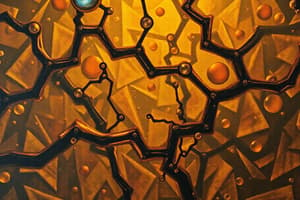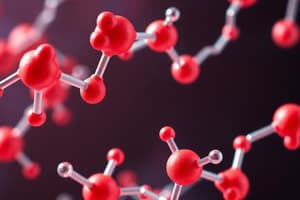Podcast
Questions and Answers
What is one of the primary advantages of molecular diagnostics?
What is one of the primary advantages of molecular diagnostics?
- Increased complexity in analysis
- Higher costs
- Improvement in sensitivity (correct)
- Increased time for results
What is the purpose of amniocentesis in genetic testing?
What is the purpose of amniocentesis in genetic testing?
- To evaluate kidney function
- To assess for metabolic disorders
- To test for infectious diseases
- To detect chromosome abnormalities (correct)
How does fluorescence in situ hybridization (FISH) assist in genetic diagnostics?
How does fluorescence in situ hybridization (FISH) assist in genetic diagnostics?
- By amplifying DNA
- By using fluorescence probes specific for chromosomes and genes (correct)
- By separating RNA from DNA
- By conducting enzyme assays
What is a significant characteristic of the 'probe' in a hybridization assay?
What is a significant characteristic of the 'probe' in a hybridization assay?
What type of mutation does the RFLP method primarily detect in sickle cell disease?
What type of mutation does the RFLP method primarily detect in sickle cell disease?
What is the main purpose of dot blot assays?
What is the main purpose of dot blot assays?
Which statement accurately describes hybridization in molecular diagnostics?
Which statement accurately describes hybridization in molecular diagnostics?
What is the result of a positive RFLP test in the context of sickle cell disease?
What is the result of a positive RFLP test in the context of sickle cell disease?
What is the primary function of the Allele-Specific Oligonucleotide (ASO) Dot Blot technique?
What is the primary function of the Allele-Specific Oligonucleotide (ASO) Dot Blot technique?
What distinguishes the Reverse Dot Blot from the ASO Dot Blot?
What distinguishes the Reverse Dot Blot from the ASO Dot Blot?
Why are Single Nucleotide Polymorphisms (SNPs) significant in the human genome?
Why are Single Nucleotide Polymorphisms (SNPs) significant in the human genome?
What technique is used to measure the binding intensity of a patient’s DNA to an SNP or gene on a microarray?
What technique is used to measure the binding intensity of a patient’s DNA to an SNP or gene on a microarray?
What is the main application of microarray technology in the medical field?
What is the main application of microarray technology in the medical field?
In microarray analysis, what does the binding of a patient’s fluorescently tagged DNA to a gene sequence signify?
In microarray analysis, what does the binding of a patient’s fluorescently tagged DNA to a gene sequence signify?
How often does a SNP occur in the human genome?
How often does a SNP occur in the human genome?
What is the role of the SNP Consortium in genomic research?
What is the role of the SNP Consortium in genomic research?
Flashcards
Molecular Diagnostics
Molecular Diagnostics
A diagnostic approach that uses DNA, RNA, and proteins to detect diseases, determine their stage, predict outcomes, and monitor treatment responses.
Fluorescence in situ hybridization (FISH)
Fluorescence in situ hybridization (FISH)
This technique uses fluorescence probes that bind to specific chromosomes or genes. The fluorescent probes can be used to identify abnormalities in chromosomes or genes related to disease.
Restriction Fragment Length Polymorphism (RFLP)
Restriction Fragment Length Polymorphism (RFLP)
A technique that uses restriction enzymes that cut DNA at specific sequences. This can be used to detect mutations in genes that cause diseases.
Hybridization
Hybridization
Signup and view all the flashcards
Dot Blot
Dot Blot
Signup and view all the flashcards
Amniocentesis
Amniocentesis
Signup and view all the flashcards
Chorionic villus sampling
Chorionic villus sampling
Signup and view all the flashcards
PCR
PCR
Signup and view all the flashcards
Reverse Dot Blot
Reverse Dot Blot
Signup and view all the flashcards
Single Nucleotide Polymorphism (SNP)
Single Nucleotide Polymorphism (SNP)
Signup and view all the flashcards
Microarray
Microarray
Signup and view all the flashcards
Microarray Analysis for Genetic Diseases
Microarray Analysis for Genetic Diseases
Signup and view all the flashcards
Allele-Specific Oligonucleotide (ASO) Dot Blot
Allele-Specific Oligonucleotide (ASO) Dot Blot
Signup and view all the flashcards
SNP Consortium
SNP Consortium
Signup and view all the flashcards
Detecting Genetic Diseases by Microarray Analysis
Detecting Genetic Diseases by Microarray Analysis
Signup and view all the flashcards
Gene Expression Analysis using Microarray Technology
Gene Expression Analysis using Microarray Technology
Signup and view all the flashcards
Study Notes
Introduction to Bioinformatics
- Bioinformatics is the application of statistics and computer science to molecular biology
- It involves organizing biological data and extracting relevant information.
Detecting Genetic Diseases
- Fetal testing identifies chromosome abnormalities and defective genes
- Amniocentesis (16 weeks, karyotype)
- Chorionic villus sampling (8-10 weeks, karyotype)
- Testing for chromosome abnormalities and defective genes also involves:
- Fluorescence in situ hybridization (FISH)
- Uses fluorescent probes specific to chromosomes or genes
- Spectral karyotyping
- Fluorescence in situ hybridization (FISH)
Molecular Diagnostics
- Molecular diagnostics uses DNA, RNA, and proteins to detect, diagnose, subclassify, predict the course of disease, and monitor responses to treatment.
- Advantages include improved sensitivity, high specificity, lower cost, and faster analysis time.
Microarray Technology
- Microarrays are chips with thousands of single-stranded DNA molecules.
- DNA from a patient is isolated, labeled, hybridized to the microarray
- A laser scanner measures the fluorescence intensity to identify SNPs or genes the patient's DNA binds to.
- Used to compare gene expression levels between different tissues and is applied to cancer research.
Allele-Specific Oligonucleotide (ASO) Dot Blot
- A method used to detect SNPs and disease markers.
- PCR amplified DNA is blotted onto a membrane, unbound probes are washed off, and bound probes are detected by radioactive or colorimetric assays.
- Applied for detection of sickle cell anemia
Reverse Dot Blot
- Instead of binding DNA to the membrane, an array of ASOs (allele-specific oligonucleotides) is bound to a membrane and hybridized to labeled target DNA.
- Used to analyze patient DNA for genetic markers/mutations.
Single Nucleotide Polymorphisms (SNPs)
- SNPs are one of the most common forms of genetic variation.
- Roughly one SNP occurs every 1,000-3,000 base pairs (bp) in human DNA.
- Most SNPs are located in non-coding regions (introns).
- SNPs influence traits and diseases.
- 10 pharmaceuticals donated millions to the SNP Consortium.
Genome-Wide Association Studies (GWAS)
- GWAS compare genomic DNA from large samples of cases and controls to identify SNPs correlated with specific traits or diseases.
- Sites differing significantly between cases and controls are validated in independent samples.
- Used to identify links between genetic markers and diseases.
The HapMap Project
- A public database containing over one million common genetic variations (SNPs) from four human populations.
- It was crucial in advancing genome-wide association studies.
Bioinformatics Databases
- GeneBank/DDBJ/EMBL: Nucleotide sequence data
- Ensembl: Human and mouse genome data
- PubMed: Literature references and abstracts
- Swiss-Prot: Protein sequences of known function
- OMIM: Catalog of human genetic diseases
Genome De Novo Sequencing (NGS)
- NGS is used to sequence whole genomes.
- Used for genomic studies using fragments of DNA.
- Steps in the NGS process: fragment and sequence, prepare and sequence reads, remove low coverage regions, break up the contigs and create scaffolds/assemble sequences from contigs and scaffolds, and closing gaps in scaffolds.
Bioinformatics Analysis
- SOAP Alignment, InDel Detection & Annotation, SNP Detection & Annotation, etc.
- Individual re-sequencing, HGMD analysis and Haplotypes construction are examples of optional bioinformatics analyses.
Medical Products and Applications of Biotechnology
- Microarray technology is a method for analyzing the expression of genes in different tissues.
- This technique is applied to cancer research and many other biotech fields.
Studying That Suits You
Use AI to generate personalized quizzes and flashcards to suit your learning preferences.




